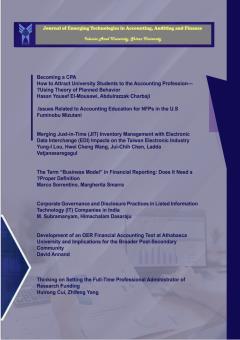Family Firms and Working Capital Management
Subject Areas : • Emerging technology in the field of Accounting and its futureMohammad Hossein Fatheh 1 * , Hossein Sadeghi 2
1 - دانشگاه پیام نور
2 - کارشناسی ارشد، گروه حسابداری، دانشگاه پیام نور، تهران، ایران.
Keywords: Working Capital Management, Family Firms, Receivables Collection Period, Debt Payment Period, Inventory Turnover Period.,
Abstract :
Abstract
Objectives: This research aims to investigate the relationship between family firms and working capital management. Working capital management involves the management of current assets and liabilities to achieve a balance that maximizes shareholder returns on investments.
Methodology/Design/Approach: This applied study employs a causal correlational methodology. The statistical population consists of all firms listed on the Tehran Stock Exchange. Using systematic elimination sampling, 136 firms were selected as the research sample and analyzed over a ten-year period from 2014 to 2023.
Findings: The results indicate an inverse relationship between family firms and the cash conversion cycle. Additionally, there is a direct relationship between family firms and the period for collecting receivables. Furthermore, a direct relationship exists between family firms and the inventory turnover period, while an inverse relationship is observed between family firms and the period for debt repayment.
Innovation: This research contributes to the existing literature by providing insights into how family ownership influences working capital management practices. It highlights the unique dynamics of family firms in managing their operating cycles compared to non-family firms, offering practical implications for stakeholders in understanding how ownership structure can affect financial performance.
Adhikari, H. P., Krolikowski, M. W., Malm, J., & Sah, N. B. (2021). Working capital (mis)management: Impact of executive age. Accounting & Finance, 61(1), 727–761. https://doi.org/10.1111/acfi.12457.
Adhikari, H. P., & Sutton, N. K. (2016). All in the family: The effect of family ownership on acquisition performance. Journal of Economics and Business, 88, 65–78. https://doi.org/10.1016/j.jeconbus.2016.01.001.
Aktas, N., Croci, E., & Petmezas, D. (2015). Is working capital management value-enhancing? Evidence from firm performance and investments. Journal of Corporate Finance, 30, 98–113. https://doi.org/10.1016/j.jcorpfin.2014.12.006 .
Badavarnahani, Y., & Taghizadeh Khanqah, V. (2016). The relationship between working capital management and investment inefficiency. Quarterly Journal of Asset and Supply Management, 4(3), 17-38. Barros, V., Falcão, P. F., & Sarmento, J. M. (2021). Are more sustainable firms able to operate with lower working capital requirements? Finance Research Letters, 46, 102407. https://doi.org/10.1016/j.frl.2021.102407.
Bianco, M., Bontempi, M.E., Golinelli, R., & Parigi, G. (2013). Family firms’ investments, uncertainty and opacity. Small Business Economics, 40(4), 1035–1058. https://doi.org/10.1007/s11187-012-9439-0.
Burney, R.B., James, H.L., & Wang, H. (2021). Working capital management and CEO age. Journal of Behavioral and Experimental Finance, 30, 100496. https://doi.org/10.1016/j.jbef.2021.100496.
Caprio, L., Del Giudice, A., & Signori, A. (2020). Cash holdings in family firms: CEO identity and implications for firm value. European Financial Management, 26(2), 386–415. Eskandarnejad, S., Baradaran Hassanzadeh, R., & Taheri, H. (2020). The effect of working capital management on the profitability of companies listed in Tehran Stock Exchange in production gap based business cycles.Quarterly Journal of Asset and Supply Management, 8 (2), 31-48.
Ghodrati, H., & Feizi, S.(2015). The effect of corporate governance on earnings management in Tehran Stock Exchange.Auditing Knowledge, No.(58), 205-232.
González, M., Guzmán, A., Pombo, C., & Trujillo, M.A.(2012). Family firms and financial performance: The cost of growing.Emerging Markets Review, 13(4), 626–649.
Hansen, C., & Block, J.H.(2020). Exploring the relation between family involvement and firms’ financial performance: A replication and extension meta-analysis.Journal of Business Venturing Insights, 13, e00158.
Kieschnick, R., Laplante, M., & Moussawi,R.(2013). Working capital management and shareholders’ wealth.Review of Finance, 17(5), 1827–1852.
Le, B. (2019). Working capital management and firm’s valuation profitability and risk: Evidence from a developing market.International Journal of Managerial Finance,15(2),191-204 https://doi.org/10.1108/IJMF-01-2018-0012.
Mazaheri, M. & Shokrizadeh, H. R. (2021). Investigating the effect of working capital management on stock liquidity in companies listed in Tehran Stock Exchange.New Business Management Models,4(9),20-29.
Mehrazin, A. R., Ghobadian, B., Forootan, O. & Taghipour, M. (2013). Family ownership, non-family ownership of companies and earnings management. Auditing Knowledge,13(52),1-16.
N Minh Ha, B. N Do , T.T Ngo. (2022). The impact of family ownership on firm performance: A study on Vietnam. Cogent Economics & Finance. https://doi.org/10.1080/23322039.xxxxxx
Nabavi Chashemi, S. A. & Asadi,V.(2021). Investigating the relationship between management ability and working capital management.New Research Approaches in Management and Accounting, 83(10), 565-583.
Nastiti, P. K. Y., Atahau,A.D.R.& Supramono,S.(2019). Working capital management and its influence on profitability and sustainable growth.Business: Theory and Practice,20(61-68) https://doi.org/10.3846/btp.2019.xxxxxx.
Sah, N. B., Banerjee, A., Malm, J. & Rahman, A. (2022). A good name is better than riches: Family firms and working capital management.Journal of Behavioral and Experimental Finance,33(2022)100599.
Amore, M. D. & Pelucco, V. & Quarato, F. (2022). Family ownership during the COVID-19 pandemic.Journal of Banking & Finance,135(February 2022),106385.
Nobanee, H. & Haddad, A. E. (2014). Working capital management and corporate profitability of Japanese firms. Empirical Economics Letters,13(1),39–44.
Murro, P., & Peruzzi, V. (2019). Family firms and access to credit: Is family ownership beneficial? Journal of Banking & Finance, 101, 173-187. https://doi.org/10.1016/j.jbankfin.2019.02.006
Bacci, S., Cirillo, A., Mussolino, D., & Terzani, S. (2018). The influence of family ownership dispersion on debt level in privately held firms. Small Business Economics, 51(3), 557–576. https://doi.org/10.1007/s11187-017-9930-2.
Sepasi, S., Hassani, H., & Salmanian, A. (2017). Working capital management, financial performance and financing constraints: Evidence from Tehran Stock Exchange. Quarterly Journal of Capital Management, Asset and Financing, 5, 96-116. https://doi.org/10.22059/jcm.2017.40249.
Zellweger, T. M., Nason, R. S., Nordqvist, M., & Brush, C. G. (2013). Why do family firms strive for nonfinancial goals? An organizational identity perspective. Entrepreneurship Theory and Practice, 37(2), 229–248. https://doi.org/10.1111/j.1540-6520.2011.00466.x.

